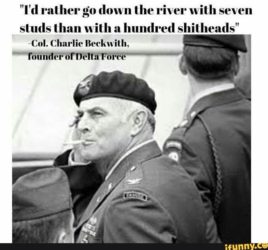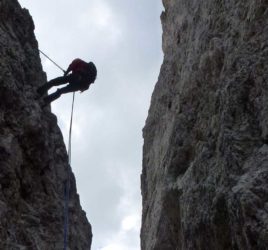The Path of a Warrior
I’ve had several conversations lately about the path of the warrior – especially as it relates to studying ninjutsu. I thought I’d take an entry and express what this thing is all about – at least to me, right now at this moment in my personal evolution. (My way of saying this could easily change in a few years based on me getting some more mileage/experiences under my belt…)
Ninjutsu, the martial art I study, attracts more than its share of nut jobs. In fairness, all martial arts styles have their percentage of whackos – god knows I’ve met plenty – but there’s something about the whole “ninja” thing that sends people into loopy Obi Wan Kenobi behavior without even having the ability to throw a proper punch. People have this idea that they can achieve some sort of supernatural ability to deal with attackers with a flick of the finger and a wink of the eye.
It.
Don’t.
Work.
That.
Way. (and yes, I’m using bad grammar for effect, dammit)
People often embark on the path of a warrior without fully comprehending what it means. It’s a novelty. Something cool. “Hey man, check me out…I’m a warrior now.” They have this notion with the right look (camo gi, tabi, face mask) or by chucking shuriken on a Youtube video they can simply start referring to themselves as a “ninja warrior.”** They go looking for something that’s not there; some sort of shortcut to martial invulnerability and this attitude of invincibility. When they don’t find it, they tend to short-circuit and immediately search for an excuse or someone else to blame for their inability to stay the course. Because they’ve found what actually IS on the path of a warrior: endless challenges and obstacles. And worse: they lack the ability to persevere in the face of those challenges.
A lot of folks equate being a warrior with being an amazing fighter. In reality, the path of a warrior is something you choose knowing full well that the only thing before you is an infinite amount of hard work, frustration, challenges, and temptations to stray from the path. Along the way, you might learn how to be a good fighter, but that’s not the essence of warriorship. I know plenty of good fighters; I know very few true warriors.
The few I am fortunate enough to know all share one thing in common: an inner drive of such power that any obstacle set before them simply stands no chance. They will either go through it, around it, seduce it, cajole it, or otherwise overcome it on their way to achieving whatever goal they have in mind.
There’s more…
Along with that incredible drive comes an acute and honest realization that challenge isn’t something that happens once or twice and then the gates of some proverbial heaven open before them; challenge happens for as long as they remain on the path of a warrior. There’s no end.
EVER.
I’ve often remarked that there’s a definite sense of masochism that goes along with some of the more intense training in the dojo I’m lucky enough to study at. It’s a sort-of running joke with my training partners, but there’s truth there as well. You’ve got to love the pain; you’ve got to love the struggle; you’ve got to love the nights when nothing makes sense; you’ve got to love the frustration and uncertainty of the training – of walking the path. This is what it means to be alive – truly alive – forever testing yourself against all challenges and insecurities. Without that spirit of contest, without that spike of adrenaline when things don’t go right, without that attitude of “WTF happens now?” there’s no sense of knowing the greatness that comes from persevering in the face of bad times.
Warriors understand this.
They actualize a concept known as “fudoshin,” – “immovable spirit.” While a literal translation might lead one to assume that fudoshin could be likened to simply being stubborn, it’s anything but. Fudoshin, in essence, is what defines a warrior: that drive, that willingness to accept the challenges on the path as the price of living a life filled with the potential of higher personal evolution and an understanding of our own place and role within the scheme of the universe.
There are no shortcuts. There are no excuses.
There’s only one easy way out: stop walking the path.
Of course, the ones who stop walking the path always have excuses ready. And the common denominator in all these excuses is that they’re externally-focused. “Things have changed.” “It’s not the way it used to be.” “I’m too busy.” True warriors are always looking to improve themselves so they spend more and more time taking care of their own failings and faults instead of looking for someone else to blame their shortcomings on. Warriors know that the ability to persevere and stay on the path comes from ridding themselves of the personal junk and clutter that affects us all. They internalize and work to vanquish their own demons through brutally honest self-assessment rather than spend their time only looking outside themselves.
It’s not easy. But then, no one said it would be.
That’s the path warriors choose to walk. Personally, I wouldn’t want it any other way.
** Which, of course, will cause some people to say, “Yeah, but Jon, on your website and elsewhere, you refer to yourself as a Ninja. Aren’t you just being hypocritical?” The answer is no: I use the term “ninja” to help market my personal brand and separate myself from the pack of other authors and producers since very few – if any – of them have spent the last two decades studying ninjutsu with acknowledged senior teachers in the art. I don’t purport to be an expert on ninjutsu; I don’t have a DVD series; I don’t even have a training group or corny Youtube videos filled with bad techno music (although I do have a few videos showing me doing some techniques). And I certainly don’t imagine myself creeping about the dark with a sword across my back. What I do have is fudoshin – and I happen to train and study my ass off, working to apply the principles of ninjutsu outside of the dojo to better my life, my family’s, and the lives of those less fortunate than myself – so I’m perfectly fine with the idea of using the term “ninja” as it relates to the actual definition of the term rather than the stereotypical silliness others would prefer to lazily employ. ‘Nuff said.
![]()
Did you enjoy this blog post? If so, please subscribe right now!
Get It By EMail | Add to iGoogle | RSS/XML Feed
Liked this post? Please share it!
Get this and other great articles from the source at www.JonFMerz.net




Jon,
An excellent post and explanation of warriorship. Thank you for putting it in writing. I’d also like to add that the role of the warrior is NOT to kick ass it’s to create a safe space where children can play, families can flourish and society as a whole can grow in peace and harmony. Sometimes that does indeed require conflict but only as a last resort. The true warrior walks the path of peace. There are many warriors that never step into a dojo and certainly don’t know how to throw a punch but they have fudoshin in abundance. These warriors also need to be acknowledged.
See you Friday.
~B
Great points, Barry – thanks for commenting!
Spot on synopsis Jon. Very true and well communicated!
Thank you, Todd – much appreciated.
Jon
Thanks for the wisdom & insight.
KS
Thanks Ken!
One of the best, most compact ways I’ve heard this summarized:
If it wasn’t hard, it wouldn’t be heroic.
Great thoughts. Sticking this in #the5.
Thank you, Chris! Hey, I made the #the5! 🙂
Thank you Jon,
This was an excellent post.
Rich
Thanks Rich! Glad you liked it!
Jon, great post. Fudoshin is something I certainly need to improve upon. I also got a kick out of the common theme in responders. Its almost like they’ve all been out there in the shadows watching you. Thank you again for this post.
Thanks Joe – always great to hear from you!